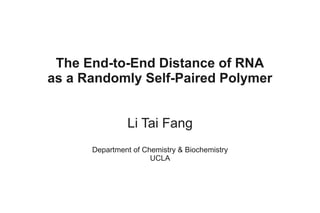
The End-to-End Distance of RNA as a Randomly Self-Paired Polymer
- 1. The End-to-End Distance of RNA as a Randomly Self-Paired Polymer Li Tai Fang Department of Chemistry & Biochemistry UCLA
- 2. RNA a biopolymer consisting of 4 different species of monomers (bases): G, C, A, U G–C A –U secondary G–U structure 3' 5'
- 3. generic vs. sequence-specific properties ● Regardless of sequence or length, we can predict ● Pairing fraction: 60% ● Average loop size: 8 ● Average duplex length: 4 ● 5' – 3' distance
- 4. Association of 5' – 3' required for: ● Efficient replication ● Efficient translation of viral RNA of mRNA complementary RNA binding sequence protein e.g., HIV-1, Influenza, Sindbis, etc.
- 5. Question: How do the 5' and 3' ends of long RNAs find each other? Answer: The ends of RNA are always in close proximity, regardless of sequence or length ! Yoffe A. et al, 2010
- 8. Circle Diagram ● 60% of bases are paired ● duplex length ≈ 4 ● Inspired the “randomly self-paired polymer” model
- 9. randomly self-paired polymer e.g., NT = 1000 NT,eff = 550 Np = 600 Np,eff = 150
- 10. general approach 1) pi = probability that the ith set of “base-pair(s)” -------will bring the ends to less than/equal to X 2) P(X) = at least one of those sets will occur = 1 – (1 – pi)·(1 – pj)·(1 – pk)· … ·(1 – pz) (X) = P(X) – P(X–1) = probability R ee is X X = X (X) · X
- 11. preview of the results: Fang, L. T., J. Theor. Biol., 2011
- 12. Let's start the grunt work Reminder: RNA: Model: NT = 1000 NT,eff = 550 Np = 600 Np,eff = 150 st Now, the 1 challenge:
- 13. probability of a particular set of pairs i j k l m n p(i) = 150/550 p(ij) = 1 /549 = p (this partial set) p(k) = 148/548 = p(i) p(i – j) p(k) p(k – l) p(m) p(m – n) p(kl) = 1 /547 p(m) = 146/546 p(mn) = 1 /545 depends on NT,eff, Np,eff, and B
- 14. Next challenge: ● We have pi = p(NT,eff, Np,eff, B) ● We want P(X) = 1 – (1 – pi)·(1 – pj)·(1 – pk)· … ·(1 – pz) Let (B) = number of ways to make a set of pairs Then, P(X) = 1 – (1 – pB=1)B=1 · (1 – pB=2)B=2 · … · (1 – pBmax)Bmax x1 x2 x3 x4 B = 3: i j k l m n
- 15. Task: find (B) ● 1st, find the number of sets {x1, x2, …, xB+1}, such that X = x1+ x2+ … + xB+1 ● for B = 3, X = 10: # of ways to arrange these: X+B (X+B)! = B X! B!
- 16. For each {xi}, how many ways to move the middle regions? vs. i j k l i j k l Navailable NT,eff – X – B – 1 = B–1 B–1
- 17. Consider all X's X X+B B NT,eff – X – B – 1 B–1 Xi=0 Missing something...... base-pairing “crossovers:” (a) (b) (c) vs. (a) (b) (c) i j k l i j k l
- 18. Crossovers are also known as pseudoknots ● X = xa + xb + x c as long as xb j – i ____ and xb l – k ● 2 ways to connect each middle region ● undercount by 2(B – 1) Now, let's put it all together
- 19. ( NT,eff , X, B ) X = 2 (B – 1) X+B B NT,eff – X – B – 1 B–1 Xi=0
- 20. Once again, the general approach where end-to-end distance X P(X) = at least one of these pairs will occur P(X) = 1 – (1 – pi)·(1 – pj)·(1 – pk)· … ·(1 – pz) P(X) = 1 – (1 – pB=1) B=1 · (1 – pB=2) B=2 · … · (1 – pBmax) Bmax ● (X) = P(X) – P(X–1)
- 21. Probability distribution of end-to-end distances <X> = 14.4 Fang, L. T., J. Theor. Biol., 2011
- 22. end-to-end distance vs. sequence length X = X (X) · X Fang, L. T., J. Theor. Biol., 2011
- 23. 1/4 Scaling law: <X> ~ N Fang, L. T., J. Theor. Biol., 2011
- 24. Once again: ● The ends of a self-paired polymer, such as RNA, are always in close proximity. ● This is a generic feature. ● Comparison of end-to-end distances: ● random or worm-like polymers: X N1/2 ● randomly branching polymers: X N1/4 ● randomly self-paired polymers: X N1/8
- 25. Acknowledgment ● Thesis advisors ● Professors Bill Gelbart and Chuck Knobler ● Thanks to ● Professor Avinoam Ben-Shaul @ Hebrew University of Jerusalem
